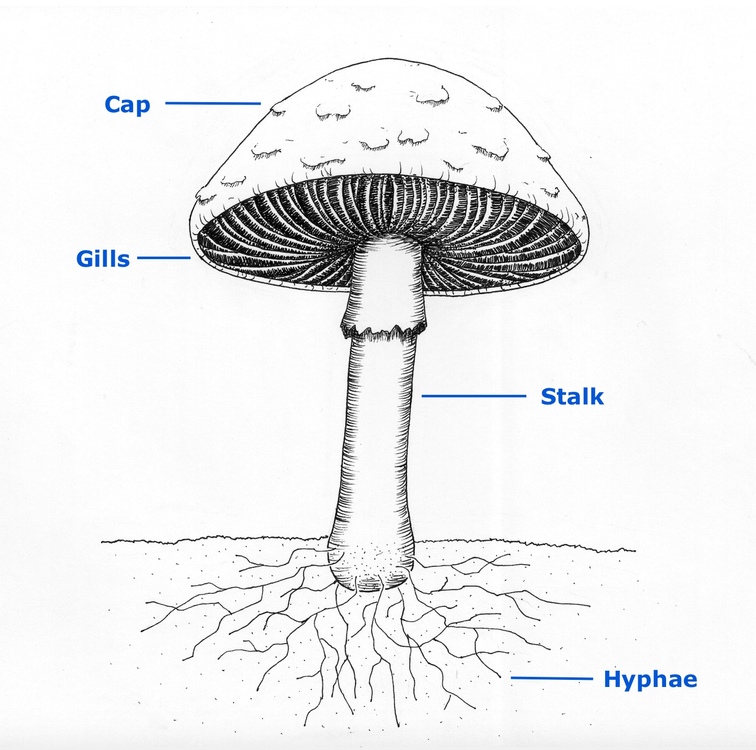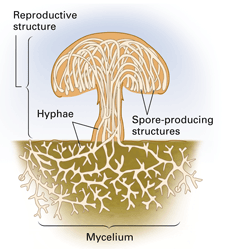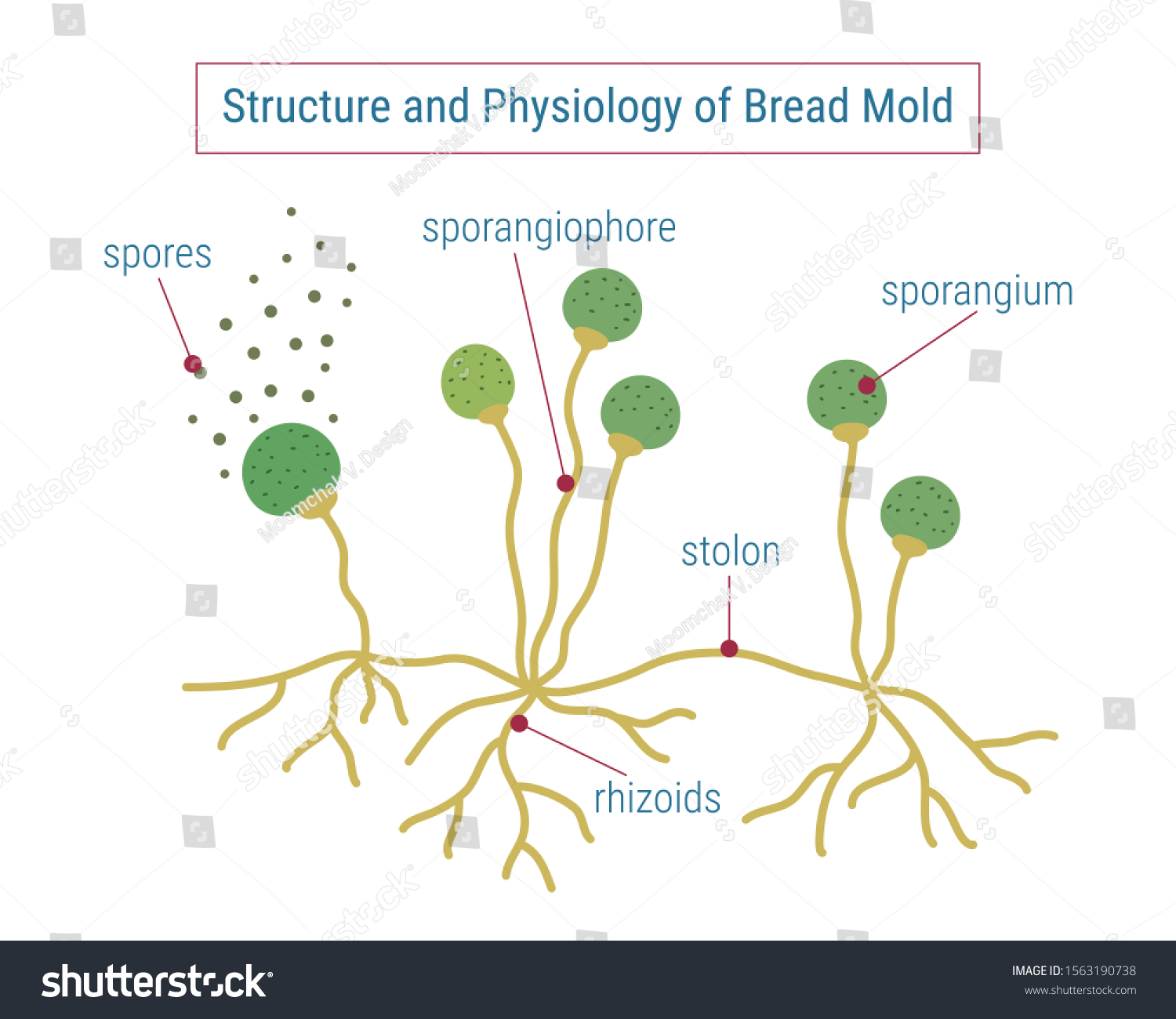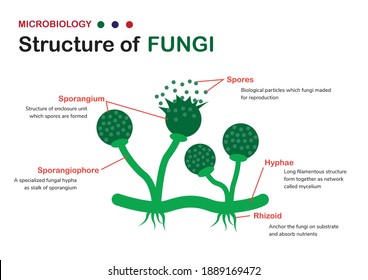These hyphae together form a mesh-like structure called mycelium. This b coral fungus displays brightly-colored fruiting bodies.

Fungal Life Cycles Spores And More Science Learning Hub

Introduction To Fungi The Natural Farmer
1
The nucleus controls and regulates the activities of the cell eg growth and metabolism and carries the genes.
Structure of fungi. The spore walls are smooth and contain cellulose which is found in the cell walls of plants but not fungi. The other slugs are transformed into spores. The fine structure of spores and many of the other tiny parts of fungi that you will want to look at under the microscope are almost completely translucent.
Reporting of fungi damage to wood commonly called water damage decay or rot is limited to the area below the first main floor of the structure as defined in 27-1085 K3f SCRR At the time of our inspection there were visibly damaged wooden members eg. Biosynthesis is a unique feature of the fungal cell wall. They grow on living or dead trees.
Bracket and crust fungi are as varied in size colour and texture as cap-and-stem mushrooms but their habitat range is much more restricted. Each hypha is comprised of at least one cell encapsulated by a protective cell wall typically made of chitin and contain internal septa which serve to divide the cells. The real difference is that fungi contain a molecule called beta-glucan a type of fiber in their cell walls.
We have also found that tannic acid and propyl gallate but not gallic acid were inhibitory to foodborne bacteria aquatic bacteria and off-flavor-producing microorganisms. TRNA structure and function 1. The structure of fungi can be explained in the following points.
Tree roots brown are connected to the symbiotic mycorrhizal structure bright white and. Many of these funguslike organisms are included in the kingdom Chromista. Cell Structure and Function.
Many plants depend on fungi to help extract nutrients from the soil. Pathogenic bacteria and fungi have developed the means of survival in animal tissue. Comunicata Scientiae is an international journal publishing research related to horticultural crops.
Like in humans plants also possess siderophore binding proteins involved in host defense like the major birch pollen allergen Bet v 1 which are usually secreted and possess a lipocalin-like structure. Sedimentation constant 38S Molecular. Fungi consist of long thread-like structures known as hyphae.
Articles in the journal deal with all areas of horticulture - fruits vegetables aromatic and medicinal plants edible fungi ornamentals and landscape architecture under temperate subtropical tropical and. Send a sample to the Plant Disease Clinic for verification. This electron micrograph shows c the spore-bearing structures of Aspergillus a type of toxic fungi found mostly in soil and plants.
They come in all sorts of shapes including rods spirals and spheres. Fungi are most closely related to a group of amoebae called nucleariids. Fungi are used in the production of chemicals in the drug manufacturing industries and also have medicinal uses.
Almost all the fungi have a filamentous structure except the yeast cells. This is the page for the University of Wisconsin Madison Department of Botany Instructional Resources Page. The seven kingdoms of living things are divided into two major groups.
They can be either single-celled or multicellular organism. Cell Structure and Function. Some pored fungi can grow either as brackets or with central stems and they are included here Also included are a few gilled members of the family Polyporaceae.
Saakre Manjesh 2014-11-105 2. There are two prokaryotic kingdoms and five eukaryotic kingdoms. Their cell structure is unique in that they dont have a nucleus and most bacteria have cell walls similar to plant cells.
Fungus plural fungi any of about 144000 known species of organisms of the kingdom Fungi which includes the yeasts rusts smuts mildews molds and mushroomsThere are also many funguslike organisms including slime molds and oomycetes water molds that do not belong to kingdom Fungi but are often called fungi. While all fungi share some common characteristics they can be broken into groups. The growth of many fungi yeasts bacteria and viruses was inhibited by tannins.
T-RNAs are small molecules with about 74 95 ribonucleotides. There are huge fundamental differences between the ways these two groups go about living. Fungi are the group of single celled and multicelled organisms that are nonmotile.
Bacteria are single-celled microorganisms. Termite other wood-destroying insects and fungi Note. Septa are important as they allow cellular organelles eg ribosomes to pass between cells via large pores.
Opisthokonts share two conspicuous features that are uncommon in other eukaryotes. Some bacteria can swim around using long tails called flagella. The cell membranes of a variety of different bacteria fungi animal and plant cells contain aquaporins through which water can flow more rapidly into and out of the cell than by.
However scientists who study fungi mycologists disagree on the best taxonomic structure. Fungus are a kingdom of usually multicellular eukaryotic organisms that are heterotrophs cannot make their own food and have important roles in nutrient cycling in an ecosystemFungi reproduce both sexually and asexually and they also have symbiotic associations with plants and bacteriaHowever they are also responsible for some diseases in plants. Finding a fungal fruiting structure on a dead needle is not proof that the tree has a needlecast disease.
About a third of the slugs in in the pseudoplasmodium become the stalk. As a single mass they act together to produce a single stalked spore-producing structure. However not all species of fungi contain septa.
TRNA t-RNA transfer RNA is also named as S-RNA soluble or supernatant RNA and adaptor RNA. Fungi provide essential nutrients for the growth of plants. The cell wall of fungi is a dynamic structure that protects the cell from environmental stress and prevents from various effects that are caused due to changes in osmotic pressure.
T-RNA is a family of nearly 60 small sized ribonucleic acids. Fungi are eukaryotes and have a complex cellular organization. Other fungi that grow on dead or dying needles but do not cause needlecast may form similar structures.
Aquaporins also called water channels are channel proteins from a larger family of major intrinsic proteins that form pores in the membrane of biological cells mainly facilitating transport of water between cells. A few types of fungi have structures comparable to bacterial plasmids loops of DNA. As eukaryotes fungal cells contain a membrane-bound nucleus where the DNA is wrapped around histone proteins.
Others just hang out or glide along. Nucleus in biology a specialized structure occurring in most cells except bacteria and blue-green algae and separated from the rest of the cell by a double layer the nuclear membrane. 10 15 of total cellular RNA is t-RNA.
Almost all cells in this group have flat mitochondrial cristae while flagellated cells typically have a single emergent flagellum that inserts at the posterior end of the cell Cavalier-Smith 1987. Many species of fungus produce the familiar mushroom a which is a reproductive structure.

Structure Of Fungal Cell With Diagram Fungi

Fungi Structure Basics Heterotrophs Release Enzymes To Absorb

Fungi Structure Diagram And Taxonomic Position Of Fungi

Structure Of Fungi Know About The Structure Of Fungi The Live Learns

Chapter 18 Concept 18 1
Fungi Basidiomycota The Club Fungi Sparknotes

Structure Physiology Fungi Anatomy Mold Diagram Stock Vector Royalty Free 1563190738

Fungi Structure Images Stock Photos Vectors Shutterstock
